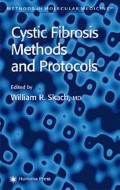Abstract
Cloning of the cystic fibrosis (CF) gene provided, for the first time, the structural information needed to more precisely define the CF defect (1-3). This genetic information was used to develop powerful molecular and antibody reagents that helped define cystic fibrosis transmembrane conductance regulator (CFTR) structure-function relationships and characterize CFTR expression throughout the body. This chapter focuses on how genetic information can be used to develop antipeptide antibodies and how these antibodies can be used to immunolocalize proteins in intact and cultured cells. By identifying which cells expressed CFTR, and correlating that information with existing knowledge of the physiology of those cells, the role of CFTR in normal cell function and the pathophysiology of CF was elucidated.
Access this chapter
Tax calculation will be finalised at checkout
Purchases are for personal use only
References
Quinton, P. M. (1990) Cystic fibrosis: a disease in electrolyte transport. FASEB J. 4, 2709–2717.
Welsh, M. J. (1990) Abnormal regulation of ion channels in cystic fibrosis epithe-lia. FASEB J. 4, 2718–2725.
Riordan, J. R., Rommens, J. M., Kerem, B., et al (1989) Identification of the cystic fibrosis gene: Cloning and characterization of complementary DNA. Science 245, 1066-1073.
Coons, A. H., Creech, H. J., and Jones, R. N. (1941) Immunological properties of an antibody containing a fluorescent group. Proc. Soc. Exp. Biol. Med. 47, 200.
Chesselet, M.-F. (ed.) (1990) In Situ Hybridization Histochemistry. CRC Press, Boca Raton, FL.
Cohn, J. A., Melhus, O., Page, L. J., Dittrich, K., and Vigna, S. (1991) CFTR: Development of high-affinity antibodies and localization in sweat gland. Biochem. Biophys. Res. Comm. 181, 36-43. 215 7. Marino, C. R., Matovcik, L. M., Gorelick, F. S., and Cohn, J. A. (1991) Localization of the cystic fibrosis transmembrane conductance regulator in pancreas. J. Clin. Invest. 88, 712–716.
Czernik, A. J., Girault, J. A., Nairn, A. C., et al (1991) Production of phosphory-lation state-specific antibodies. Meth. Enzymol. 201, 264–283.
Taylor, C. R. and Cote, R. J. (ed.) (1994) Immunomicroscopy: A Diagnostic Tool for the Surgical Pathologist, 2nd ed., W. B. Saunders, Philadelphia, PA.
Claas, A., Sommer, M., de Jonge, H. R., Kalin, N., and Tummler, B. (2000) Applicability of different antibodies for immunohistochemical localization of CFTR in sweat glands from healthy controls and from patients with cystic fibrosis. J. Histochem. Cytochem. 48, 831–837.
McLean, I. W. and Nakane, P. K. (1974) Periodate-lysine-parafromaldehyde fixative: a new fixation for immunoelectron microscopy. J. Histochem. Cytochem. 22, 1077–1083.
Griffiths, G. (ed.) (1993) Fine Structure Immuno cy to chemistry. Springer Verlag, Heidelberg, Germany.
Cuello, A. C. (ed.) (1993) Immunohistochemistry II. John Wiley and Sons, West Sussex, UK.
Marino, C. R., Jeanes, V., Boron, W. F., and Schmitt, B. M. (1999) Expression and distribution of the Na+-HCO3∼ cotransporter in human pancreas. Am. J. Physiol. 277, G487–G494.
Prince, L. S., Tousson, A., and Marchase, R. B. (1993) Cell surface labeling of CFTR in T84 cells. Am. J. Physiol. 264, C491–C498.
Tousson, A., Fuller, C. M., and Benos, D. J. (1996) Apical recruitment of CFTR in T-84 cells is dependent on cAMP and micro tubules but not Ca2+or microfila-ments. J. Cell Sci. 109, 1325–1334.
Author information
Authors and Affiliations
Editor information
Editors and Affiliations
Rights and permissions
Copyright information
© 2002 Humana Press Inc.
About this protocol
Cite this protocol
Marino, C.R. (2002). Immunolocalization of CFTR in Intact Tissue and Cultured Cells. In: Skach, W.R. (eds) Cystic Fibrosis Methods and Protocols. Methods in Molecular Medicine™, vol 70. Humana Press. https://doi.org/10.1385/1-59259-187-6:199
Download citation
DOI: https://doi.org/10.1385/1-59259-187-6:199
Publisher Name: Humana Press
Print ISBN: 978-0-89603-897-4
Online ISBN: 978-1-59259-187-9
eBook Packages: Springer Protocols

